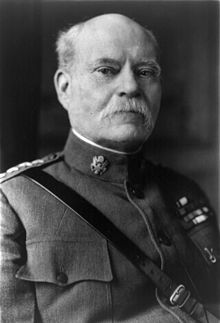Eleanora Knopf
Eleanora Frances Bliss Knopf | |
|---|---|
 1928 US Geological Survey ID Portrait | |
| Born | Eleanora Frances Bliss July 15, 1883 |
| Died | January 21, 1974 (aged 90) |
| Occupation | Geologist |
Eleanora Frances Knopf (
Early life
Eleanora Frances Bliss was born in Rosemont, Pennsylvania on July 15, 1883. Her father was General Tasker Howard Bliss — a career soldier who became Chief of Staff of the US Army during the First World War as well as a principal representative of the United States in the Allied Councils. Her mother was Eleanora Emma (Anderson) Bliss. Both sides of the family could trace their ancestry to settlers from England.[2] The Bliss family home was located near crystalline rocks which she later studied.[3] She married geologist Adolph Knopf, in 1920. They did not have children of their own, but she became a stepmother to his three children, who were already of school age at the time.[4][3]
Education
She received her early education from Florence Baldwin School.
Career

Shortly after receiving a Ph.D. in geology from Bryn Mawr and passing the
She continued to study the Stissing Mountain rocks until her retirement in 1955 but also made some expeditions to the Rocky Mountains.
Later years
After retiring Eleanora Knopf moved out to the Rocky Mountains with her husband (Adolph Knopf) to aid him with his studies, after his death in 1966 she devoted herself to completing his research regarding the Boulder Batholith but health complications arose for her.[3] She died in 1974 from arteriosclerosis in Menlo Park, California, at the age of 90.[15]
References
- ^ Oakes 2007, p. 408.
- ^ Aldrich 1980, p. 401.
- ^ a b c d e Rodgers, John (February 1977). "Memorial to Eleanora Bliss Knopf" (PDF).
- ^ a b c Aldrich 1980, p. 402.
- ^ a b Pennsylvania Conservation Heritage Project (2018). "Eleanora Frances Bliss Knopf".
- ^ Rodgers, John (1977). "Memorial to Eleanora Bliss Knopf" (PDF).
- ^ ISBN 978-0-674-62733-8.
- ^ Eckel, Edwin (1982). The Geological Society of America: Life History of a Learned Society, Issue 155. Boulder, Colorado: The Geological Society of America. pp. 37–38.
- ^ Commire 2007, p. 1044.
- ^ Helcon (2018). "Knopf, Eleanora Frances".
- ^ Helicon (2018). "Knopf, Eleanora Frances".
- ^ Bourne 2008, p. 131.
- ^ Rodgers, John (1977). "Memorial to Eleanora Bliss Knopf" (PDF).
- ^ Bourne, Jennifer A. (2008). "Eleanora Bliss Knopf and unequal erosion".
- ^ Aldrich 1980, p. 403.
Bibliography
- Oakes, Elizabeth H. (2007), Encyclopedia of World Scientists, InfoBase Publishing, ISBN 978-0816061587
- Rodgers, John (1977), " Memorial to Eleanora Bliss Knopf", Department of Geology and Geophysics, Yale University, New Haven, Connecticut, pp. 1–3.
- Aldrich, Michele L. (1980), "Knopf, Eleanora Frances Bliss", Notable American Women: The Modern Period, ISBN 9780674627338
- Aldrich, Michele L. (1993), "Women in Geology", Women of Science: Righting the Record, ISBN 9780253208132
- Commire, Anne (2007), "Knopf, Eleanora Bliss", Dictionary of Women Worldwide, Yorkin Publications, p. 1044, ISBN 9780787676766
- The Baldwin School: Eleanora Bliss Knopf, The Baldwin School, archived from the original on October 9, 2017, retrieved October 10, 2017
- Bourne, Jennifer A.; Twidale, C. Rowland (2008). "Eleanora Bliss Knopf and Unequal Erosion". Earth Sciences History. 27 (1): 132–133. .
- Bourne, Jennifer A.; Twidale, C. Rowland (2008). "Eleanora Bliss Knopf and Unequal Erosion". Earth Sciences History. 27 (1): 131–135. .
- Eckel, Edwin (1982). The Geological Society of America: Life History of a Learned Society, Issue 155. Boulder, Colorado: The Geological Society of America. pp. 37–38.
